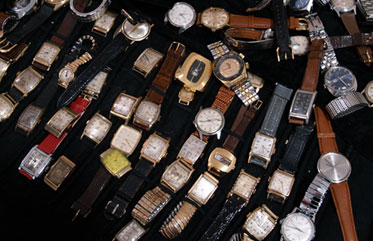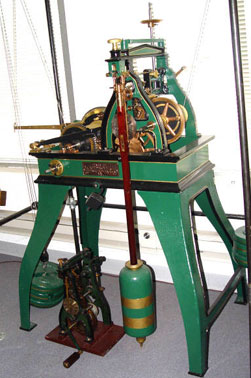DON'T SCRAP THAT TIMEPIECE...
YOU MAY BE THROWING AWAY A
RARE HISTORICAL ARTIFACT!

Ever since people first began devising ways to reliably measure time, they have been inventing and producing mechanical devices to do so. Over the past millenium literally billions of timepieces have been created, of all shapes and sizes. The history of horology is vast indeed. As new technology renders older timepieces less practical or even obsolete, many such items are discarded or disassembled for scrap. Countless clocks and watches wind up on the junk pile each year, abandoned and forgotten by their former owners as worthless trash.
BUT ARE THESE ITEMS REALLY WORTHLESS?
Every timepiece has value to the dedicated horological collector, and any watch or clock can be a treasure of historical information to a trained horological historian. It can be terribly irresponsible to discard or scrap a rare or unique watch movement just to sell the gold case to be melted for the ore value, or to destroy an intricate hand-made clock movement by removing it from its case to replace it with a modern quartz equivalent. Many of these precious movements and mechanisms date back to a time when manufacturing and assembly was done almost entirely by hand. Each of these objects bears traces of the touch of its creator, and each has a story to tell. By tossing them atop a trash heap, we silence them forever.
WHY SHOULD ANYONE CARE?
When any timepiece goes out of existence-- especially a vintage or antique timepiece-- our society as a whole risks losing a valuable part of our historical heritage. Often those who designed and fabricated the lost timepiece have themselves passed on, taking their unique personal knowledge of the horological artifact with them. Sometimes the only way one can understand the detailed history, quirks, and specific eccentricities common to a particular timepiece is by studying it to glean as much information from it as possible, as a service to furture generations of horological historians.
If all instances of a particular timepiece have ceased to exist, then (like the vanished members of an endangered species) that timepiece, and its unique historical characteristics, become "extinct." Nor can they be used for further study, or to add to our collective knowledge about other, similar, horological items.
 |
|
|
VINTAGE 1960'S PATEK PHILLIPE WRISTWATCH ESTIMATED WORTH TO AN UNEDUCATED SCRAPPER: $75-$250. TRADE VALUE IN THE LUXURY WATCH MARKET: $5,000-$7,000. ACTUAL VALUE TO A PATEK PHILLIPE COLLECTOR: ? |
UN-CASING WATCH MOVEMENTS TO SELL THE GOLD CASES
Any time a watch case, chain, or fob is sold as scrap metal for the bullion price, irreplacable historical horological objects vanish forever. Though it may be hard to resist the siren song of fast cash from the gold buyers, if one simply takes the time to seek out knowledgable collectors, often they are willing to buy those objects for MORE than the gold scrappers. Not only does this offer a valid alternative to artifact destruction, it can ultimately be more satisfying to know that a treasured antique will continue to exist and bring joy to its owner.
DISASSEMBLING WATCH OR CLOCK MOVEMENTS
Sometimes artists and costumers seek mechanical parts, cogs, wheels, watch or clock hands, or other horological spare parts for use in creating or decorating jewelry, art objects, or Steampunk costuming and gear. While not all watches and clocks can be salvaged and some spare parts are simply otherwise useless trash salvaged from the rubbish bin, sometimes functional examples of working watches and clocks are recklessly torn apart and their wheels, cogs and other parts used for non-horological purposes.
Again, we advise anyone who seeks watch and clock parts to exercise care and personal responsibility in how they obtain such parts. A working watch or clock will always have historical value as more than just a pile of machine parts. Don't tear apart an antique pocket watch that might bring several hundred dollars (or more) from the right collector just in order to obtain a few dollars worth of machine parts. There are better, less expensive, and far less destructive sources out there for gears, wheels, and other such items.

SCRAP OR ART?
If you take a broken machine to a scrapyard, then scrap it is. Reshaped, redefined, and recreated, it might become a new work of deconstructionist art. But is scrap or art the only option? Junk metal to be sold and melted? Large brass and steel gears for a new artistic repurposing project? It might be any of those things...or maybe it could be restored back to its former glory as a Seth Thomas #15 Tower Clock movement, from around 1914. A fantastic piece of vintage machinery, and still a work of art. But definitely not "scrap."
 |
 |
| Left. Before restoration. Right. During restoration. | |
 |
|
Above: After restoration. |
Let's not limit our options to Art or Scrap. Lets look at this for what it is, our Horological Heritage. Scrapping, even if the intention is to create art, takes from this heritage.
THE PHILOSOPHY OF HOROLOGICAL CONSERVATION
The craft of horological conservation is a unique blend of science and art, history and preservation. The amazing and complex beauty of these great horological artifacts still speak to us and inspire us today. Through the art of horological conservation, collectors connect with the past, and even the present and future of the human experience. Too many people in our modern age seem eager to destroy their tangible cultural heritage by permitting that heritage to wind up in trash bins or landfills. In the horological world, the sad result is that all that remains of certain clock and watch technologies are written descriptions or catalogue drawings. Horological conservators aim at preserving rare horological properties (without change in ownership or use) in cases where there is significant historical value and knowledge to be gained by the conservation.
DO YOUR PART IN PROTECTING AND PRESERVING OUR HOROLOGICAL HERITAGE... JOIN THE NAWCC TODAY.









